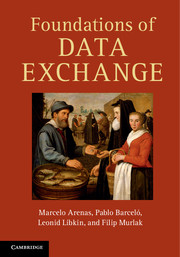Book contents
- Frontmatter
- Dedication
- Contents
- Preface
- Part One GETTING STARTED
- Part Two RELATIONAL DATA EXCHANGE
- Part Three XML DATA EXCHANGE
- 10 The problem of XML data exchange
- 11 Patterns and mappings
- 12 Building solutions
- 13 Answering tuple queries
- 14 XML-to-XML queries
- 15 XML data exchange via relations
- 16 Endnotes to Part Three
- Part Four METADATA MANAGEMENT
- References
- Index
15 - XML data exchange via relations
from Part Three - XML DATA EXCHANGE
Published online by Cambridge University Press: 05 June 2014
- Frontmatter
- Dedication
- Contents
- Preface
- Part One GETTING STARTED
- Part Two RELATIONAL DATA EXCHANGE
- Part Three XML DATA EXCHANGE
- 10 The problem of XML data exchange
- 11 Patterns and mappings
- 12 Building solutions
- 13 Answering tuple queries
- 14 XML-to-XML queries
- 15 XML data exchange via relations
- 16 Endnotes to Part Three
- Part Four METADATA MANAGEMENT
- References
- Index
Summary
So far we have tacitly assumed that one uses a native XML DBMS for performing data exchange tasks. However, this is not the only (and perhaps not even the most common) route: XML documents are often stored in relational DBMSs. Thus, it is natural to ask whether relational data exchange techniques, developed in PART TWO, can be used to perform XML data exchange tasks.
In XML terminology, translations from XML to relations are referred to as shredding of documents, whereas translations going the other way, from relations to XML, are referred to as publishing. Thus, to use relational technology for XML data exchange tasks, we can employ a two-step approach:
shred XML data into relations;
then apply a relational data-exchange engine (and publish the result back as an XML document if necessary).
The seems very natural, but the key question is whether it will work correctly. That is, are we guaranteed to have the same result as we would have gotten had we implemented a native XML data-exchange system? This is what we investigate in this chapter. It turns out that we need to impose restrictions on XML schema mappings to enable this approach, and the restrictions are similar to those we needed to ensure tractability of data exchange tasks in the previous chapters.
Translations and correctness
We now describe what we mean by correctness of translations that enable a relational data exchange system to perform XML data exchange tasks.
- Type
- Chapter
- Information
- Foundations of Data Exchange , pp. 206 - 219Publisher: Cambridge University PressPrint publication year: 2014

